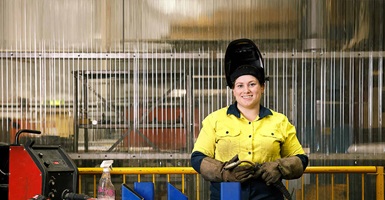Do you like the idea of working in an aquatic environment? Are you interested in keeping swimmers safe and diving in to help if someone is in trouble? Then why not look into becoming a pool lifeguard?
In this article, Chisholm Education Manager for Sport, Fitness and Massage Isaac Enbom explains what’s involved in becoming a pool lifeguard and why it can be such a rewarding job.
It’s important to note that the information provided relates to pools and commercially run aquatic facilities specifically. The rules around becoming a surf lifeguard at a beach are different.
The need for lifeguards in Australia
Right now there is massive demand for lifeguards in Australia.
“The industry is just screaming for more lifeguards,” says Isaac. “It’s been severely impacted by the pandemic – because all the pools closed for so long, many lifeguards moved on to other work and haven’t returned. In fact, a lot of aquatic facilities and businesses can’t open at capacity because they don’t have a lifeguard on deck.”
Stats on drownings
According to Royal Life Saving Australia, 294 people drowned in Australian waterways between 1 July 2020 and 30 July 2021. Of these, 30 deaths occurred in a swimming pool (a 17% decrease compared with the 10-year average).
Why choose to be a lifeguard?
Lifeguarding is well paid, offers flexible hours and can complement other work or study, says Isaac. Another big drawcard is that lifeguarding teaches you ‘skills for life’.
“You learn how to drag someone out of the water, then those are skills you keep – you just need to maintain your fitness and strength,” he says.
What does a lifeguard do?
A pool lifeguard’s role is to monitor an open body of water and respond to an aquatic emergency. It could be someone who’s in the water (a ‘guest in distress’) or a casualty.
Generally speaking, there are three components of a lifeguard’s role:
-
Supervision
Lifeguards must learn how to adequately supervise a body of water. There are different requirements depending on the size of the area (for a standard 25m pool, there may be one or two lifeguards but for larger aquatic facilities with greater risks, more lifeguards need to be on deck).
-
Rescue techniques
Another key skillset lifeguards require are rescue techniques. This may involve using floatation aids or diving in to drag someone out of the water.
“Lifeguards learn a lot of different rescue techniques based on the emergency that’s in front of them,” says Isaac. “There are basic water rescues, advanced water rescues and team water rescues.”
-
Resuscitation techniques
Pool lifeguards are also trained to provide emergency care such as first aid, oxygen administration and resuscitation if someone has taken on water.
Travel opportunities
If you have the nationally accredited lifeguarding skillset, you can generally work anywhere in Australia in an aquatic facility.
“Anywhere where there’s an open body of water that’s commercially run needs to have lifeguards,” says Isaac. “Examples of where you might find work in Victoria include your local 25m pool, Gumbuya World or URBNSURF.”
Debunking lifeguarding myths
Myth #1: Anyone can become a pool lifeguard
The truth: You need to pass certain fitness and competency tests to become a lifeguard, so it may not be the right fit for someone who is underdeveloped (an early teen) or unfit.
“You need to be able to physically pull someone out of the water and to provide CPR (on your knees providing compressions),” he says. “At Chisholm, those requirements are built into the units of competency and they’re assessed.”
Examples of some of the requirements aspiring lifeguards may need to meet include:
- Dive and retrieve an object from the deepest part of the aquatic environment (no greater than 3m)
- Swim 200m in less than six minutes without using equipment.
- Respond in a team of at least two in a simulated emergency and retrieve a casualty from a 25m non-contact position in less than 1min 45 seconds.
Myth #2: Mostly it’s males who become lifeguards.
According to the Labour Market Insights website, females make up 38% of the lifeguard workforce. “At Chisholm, we get a good mix of students wanting to become lifeguards – probably 50-50 males and females,” says Isaac.
What attributes do lifeguards need?
To become a lifeguard, you need to be fit and active, keen to ensure the safety of others and want to make a difference in the community. You also obviously need to enjoy water and being in an aquatic environment.
Pool lifeguard courses
The Certificate III in Aquatic and Community Recreation traineeship is a great option for those looking to get started in lifeguarding.
It includes on-the-job training and leads to pool lifeguard and swim teacher accreditations, as well as being a pathway to the Diploma of Sport and Recreation Management. The traineeship can be completed in just 9 months.
“The great thing about the traineeship is that you’re paid and contracted to an organisation while you’re completing the study,” says Isaac. “It can be full-time or part-time, and often it leads to ongoing employment.”
”The great thing about the traineeship is that you’re paid and contracted to an organisation while you’re completing the study” - Isaac Enbom. Education Manager for Sport, Fitness and Massage
A pool lifeguard skillset industry short course is also available to organisations (rather than the general public).
Lifeguard job opportunities
As mentioned, the employment prospects to become a lifeguard are excellent, as there is an ‘acute shortage’ of qualified lifeguards and swimming teachers across Australia at present.
“The good news is that for people who are currently unemployed, or looking at a change in career, there are jobs available right now across Australia,” Royal Life Saving Society – Australia CEO Justin Scarr says.
"The aquatic industry is great for people who need some flexibility – parents returning to the workforce, or people looking for hours that fit around their caring responsibilities.”
Lifeguarding can also be a stepping-stone to other positions in the aquatic industry such as management roles, aquatic technical operators and more.
Lifeguard salaries
The pay for lifeguards is highly variable and much of the workforce is casualised.
While it’s difficult to find official data about how much lifeguards earn in Australia, as a rough idea, indeed.com lists the average base salary for a lifeguard as $29.72 per hour, with some companies offering more than $40 an hour.
Seek.com.au says the average annual salary for lifeguard jobs in Australia ranges from $50k to $60k.
Like to learn more about becoming a lifeguard?
Chisholm is working closely with Aquatics and Recreation Victoria (ARV) to secure traineeships and support the industry. To find out more about becoming a lifeguard in Australia, check out our Certificate III in Aquatic and Community Recreation traineeship or get in touch.
To review all our aquatics courses, including short courses in Swim and Water Safety Teacher skill sets and First Aid, visit www.chisholm.edu.au/aquatics


